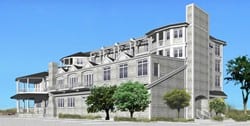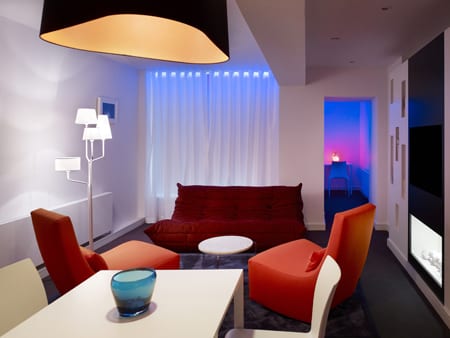Hospitality Design (HD) magazine and Culintro, a culinary trade organization in New York City that brings together restaurant professionals, have teamed up to bring a monthly online Q&A with some of the nation’s top restaurant designers. Each month, we will feature a Q&A with an industry leader, talking about his/her newest project, the industry, what works, and what’s next.
 Glen Coben
Glen Coben
Glen & Company
New York
www.glenandcompany.com
Thanks to growing up with an engineer dad, Glen Coben always knew he wanted to be an architect. And it was meant to be. After graduating from Cornell and cutting his teeth at impressive firms like Nike and the Rockwell Group, he launched his own firm, designing a slew of restaurants for some of the great chefs like Mario Batali and Marcus Samuelson. He just completed the entire Fashion 26 Wyndham hotel in New York, and is currently working on a handful of others including a ground-up 33-room luxury hotel in Madison, Connecticut, set to open next year, as well as a restaurant and lounge in Bangkok, a 450-square-foot bar in the West Village, and a renovation of the iconic Delmonico’s Italian Steakhouse in lower Manhattan. He chats with us about inspirational family trips, his non-traditional MBA, and for one project, how language barriers can be solved through design drawings.
HD: Did you always know you wanted to be an architect?
GC: As far back as I can remember, yes. I believe it was a convergence of growing up with my dad who was an engineer, the Brady Bunch (who didn’t want to be like Greg Brady, but wanted to be like his Dad!), and reading The Fountainhead. Growing up, my dad had a very dear friend who was an architect. Each time we got together, he tried to talk me out of becoming an architect…until I spent one summer during high school at Cornell’s architecture summer program. Once he saw how excited I was about the work, he never tried to talk me out of it again.
 HD: What are some of your first memories of design?
HD: What are some of your first memories of design?
GC: We traveled a lot growing up—every year we would go on a family ski trip to either Europe or the West. The European trips were amazing because we always mixed visiting cities with our ski trips. Venice, Rome, Paris and Amsterdam are clear memories of my youth.
HD: How did you end up where you are today?
GC: The short story? I was open to new experiences and always sought to learn wherever I went! The long story? After graduating from architecture at Cornell University, I was fortunate to come to New York during a mini boom-time. I tried to work in as many differently sized offices as I could, working on lots of differently scaled projects. These three years were an amazing extension of my education, as I learned about small, medium, and large-sized firms and how they worked on their projects. I worked with some amazing people during those days. I settled into a position at SITE projects and ended up staying there for five years where I learned about collaborative design from James Wines, my first mentor. He was and still is a hero of mine. At SITE I worked on the Saudi Arabian Pavilion at the 1992 Seville World’s Fair; it was awesome being able to go back and forth to Spain every month. From SITE I tried to start my own firm and fortunately was recruited by Nike to head up their retail design group, where we were responsible for the creation and rollout of Niketowns around the world. From Nike I came back to New York and re-connected with David Rockwell (my second mentor) and became a principal there. Ten years ago last month I left Rockwell Group to start my own practice. Ten years seems like yesterday!
 HD: What did working at Nike teach you/help you with where you are today?
HD: What did working at Nike teach you/help you with where you are today?
GC: My Nike experience was like getting an MBA! I learned things that I never would have dreamed of learning if I had stayed in the normal sequence of design/architectural offices. I sat on the owner’s side of the table, interviewing local architects who we would hire to execute our design vision. I learned the right way to hire someone and the correct way to fire someone. I learned how to manage budgets and schedules, and I realized that what I had learned at SITE, that telling stories about people, places, and things could inspire multiple generations of customers. That branding was more than what the ‘marketers’ were promoting, and that a brand’s values were the backbone for every story we were going to tell. As designers and architects, we have the tremendous opportunity to tell stories…whether they are about a chef, a menu, a cuisine, a location, or a hotel chain. We have the gift each and every time we lift a pen or pencil to tell a story. That’s why I do this!
HD: Why hospitality? What do you love about it?
GC: I love the fact that the restaurant or hotel has to open at some time! Having to pay rent is one of the best motivators to make decisions. Seriously, I love the chance to tell stories. Each project is unique, and my team is so fortunate to be in a position to work with amazing hoteliers and restaurateurs who have amazing stories to tell.
HD: Greatest lesson learned so far?
GC: To check my ego at the door. As architects and designers, I always strive to make sure we remember that we are in a service industry. The other lesson I learned at Nike and is based on sports: Even though one team won the championship the prior year, at the beginning of each season, every team starts out with zero wins and zero losses. Each project we work on is a new season, a new opportunity to prove ourselves. I love that idea.
 HD: What was your big break?
HD: What was your big break?
GC: Hmmm, either being hired by Jonathan Waxman to design Washington Park or working with Mario Batali, Joe and Lidia Bastianich, and their teams on Del Posto. I’m still waiting to be discovered and have my own show about restaurant design on the Food Network.
HD: What restaurant do you love for its design (one that you didn’t design)?
GC: Alain Senderens in Paris. The juxtaposition of old and new is a wonderful expression of the chef’s cuisine. The chef is a good friend of one of our clients, which makes this even more special.
HD: What are the keys to creating a successful restaurant?
GC: Restaurants are deeply personal projects. I love designing them because each project affords us the opportunity to learn about new people, places, and cuisines. We are here to interpret a chef and owner’s dreams into a reality. It’s not about me; it is about them. My team does not lose sight of this fact each time out.
 HD: Talk to us about one of your most recent restaurant designs…where, what, challenges?
HD: Talk to us about one of your most recent restaurant designs…where, what, challenges?
GC: We have been working with the noted chef/neurologist from Barcelona, Dr. Miguel Sanchez Romera on his first restaurant in New York City. This restaurant is scheduled to open later this year. We have been working together for close to two years on the design, and in this time, I have spent time with Miguel in his kitchen in Barcelona, with him at the Bouqueria shopping for food and hanging out with him. The process has been amazing—translating his culinary vision into a series of rooms, which communicate the essence of Miguel. The process has been inspirational. The only challenge was the fact that at the beginning, Miguel didn’t speak English and I didn’t speak Spanish. We communicated through drawings, sketches, and photographs, which allowed us to be very clear in what we were doing.
 HD: You recently just designed Fashion 26. Tell us a bit about the project and the design.
HD: You recently just designed Fashion 26. Tell us a bit about the project and the design.
GC: We focused on American garment making, seeking to create a sense of place that evokes a simple, uncluttered spirit, much in the way that American garments did in the turn of the 19th-20th century in this very neighborhood. Rooted in this historic period was a tradition and philosophy of style, while always having an attitude towards innovation and value. Our inspiration came from the tools used as well as the patterns created and used. This is not a European-tailored place. It is American, and we channeled the traditional patterns and pattern-making of the early great American designers and tailors to create a language appropriate to the hotel guest. Although we were hired to design all of the interior spaces, we were also hired to give the hotel a personality. Prior to coming on board, the hotel was a beautifully designed building that had no interior "concept" or personality. Our job was to create a destination that would resonate with the guest. Our mission evolved from pure interior design into a serious branding exercise. Once we settled on the theme of Fashion 26 we then filled in the gaps with each area of the project, building up the brand and developing the story about the location, the district, and how the guest relates and interacts with the hotel and spaces.
 HD: Any other project you recently completed that you loved and why?
HD: Any other project you recently completed that you loved and why?
GC: Rare in the Fashion 26 hotel. I think we captured the essence of their brand. We have been working with the owners of Rare since their first restaurant. I believe with this project we were finally able to create an immersive experience that allows the guest to feel who they are as operators and innovators in the burger world. It is a burger house mixed with steakhouse aspirations!
HD: What’s your dream project?
GC: I would love to design a golf club house and maybe a golf course as well! Seriously, I would love to design an airport terminal. I love the idea of figuring out how guests flow through spaces and how to engage them in new experiences.
HD: How do you constantly find inspiration?
GC: Everywhere I turn. Being fortunate to live in New York City, I see amazing things everyday. My team continues to inspire me with their ideas and their dedication. I taught in the interior design department at Pratt Institute last year, and was inspired by my students. Our clients inspire us—chefs who create and assemble dishes and operators who put their trust in us to create their dreams. And last but not least, my daughter inspires me every day; she sees things for the first time and tells me how amazing they are…and I am filled with joy.
HD: What cities are on your radar for development and design?
GC: New York City, Bangkok, London, Mumbai and Harrison, New York (hey, it’s where I live—I would love to design something there).
HD: What are the biggest challenges in hospitality today?
GC: We are seeing a lot more activity in the industry, so the challenge a year ago was to stay in business. Our challenge is to manage expectations of how long things take to be built. With the tools that exist today, owners tend to want to bring things to market or open sooner than can realistically happen.
(Projects pictured from top: Madison Beach Hotel, Whole Foods, Del Posto, Miguel Sanchez Romera, Fashion 26 hotel, Rare restaurant in Fashion 26 hotel)


